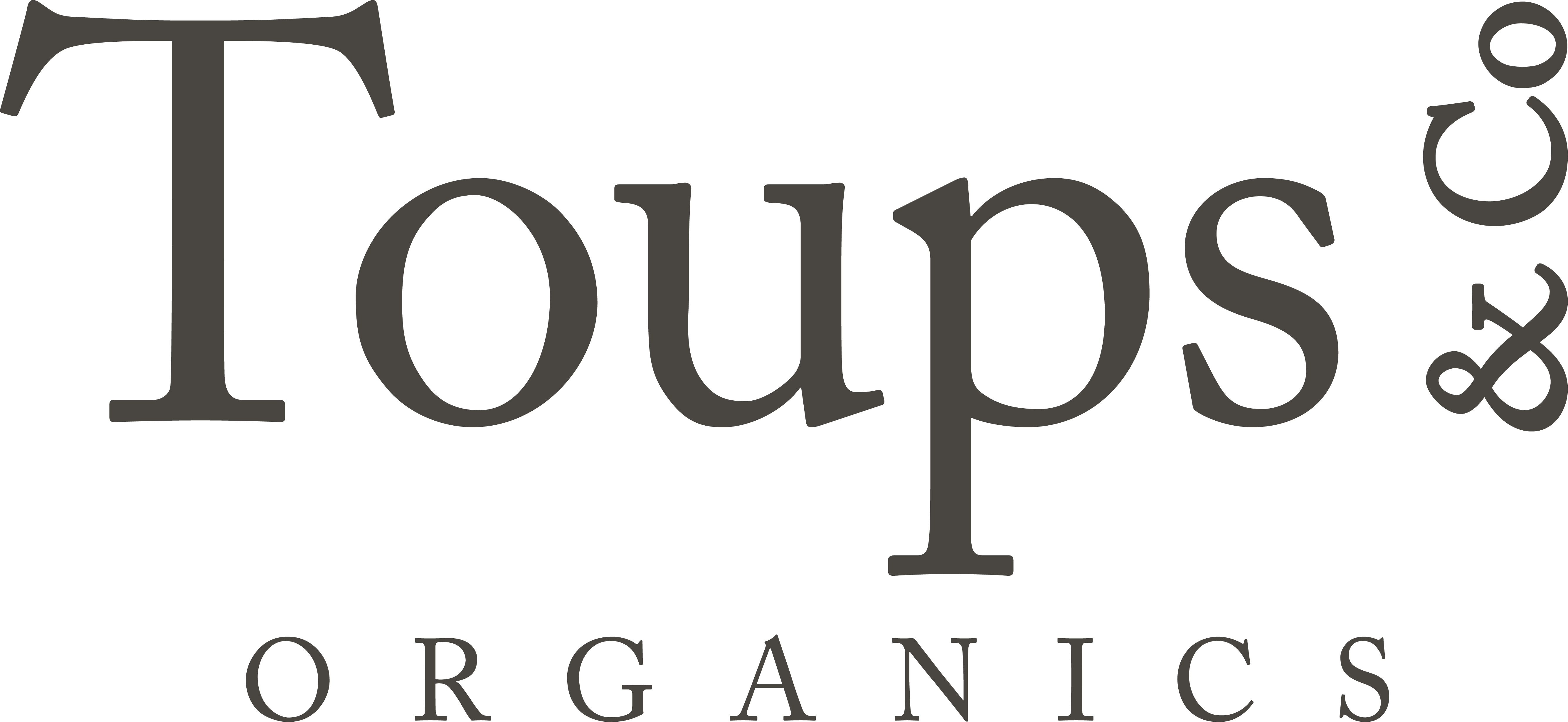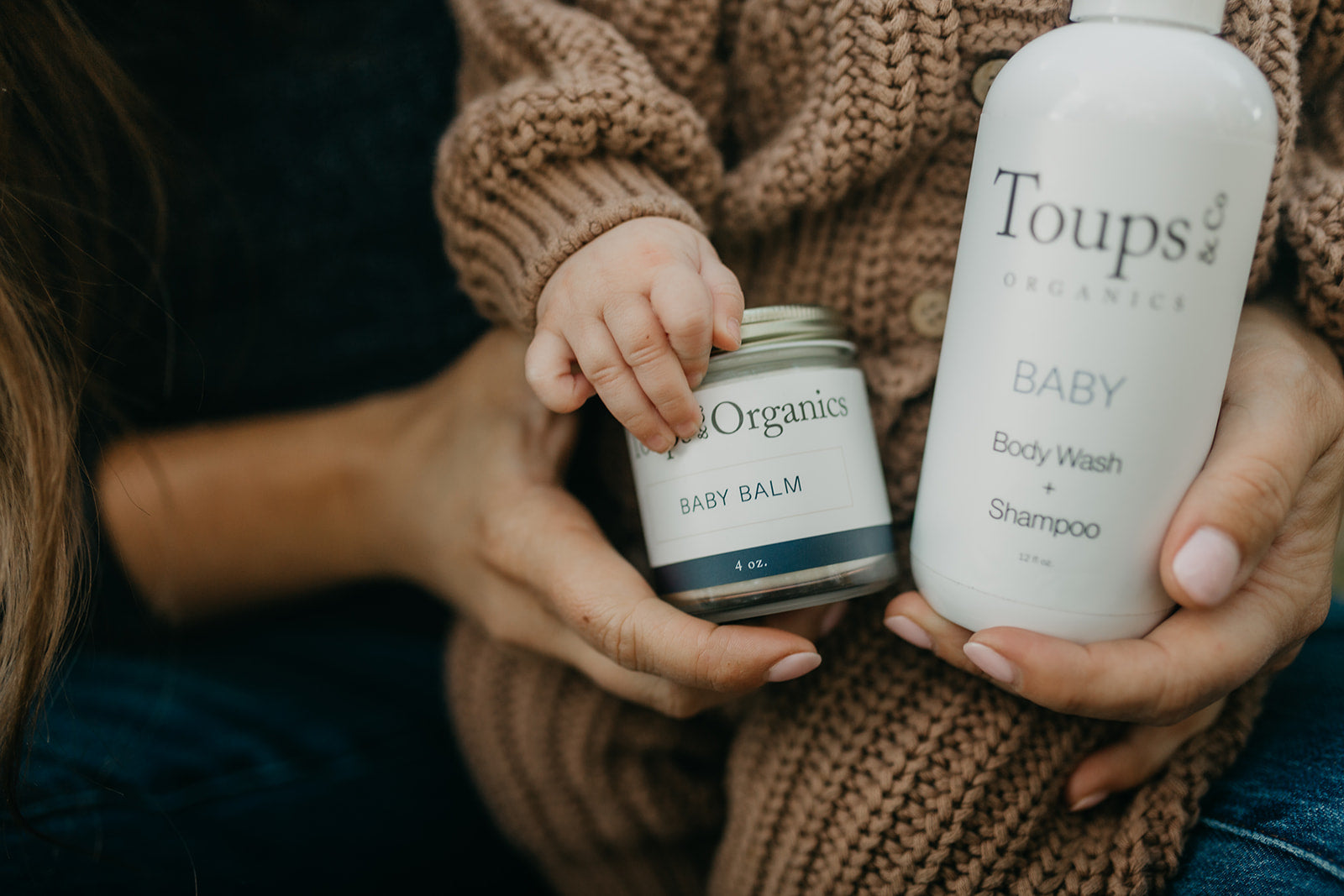Baby skin is quite delicate, and it’s home to a unique microbiome that needs protection. That’s why it’s so important to know what’s in baby bath products and to understand how simple ingredients impact your child’s skin and immune system.
You’ve probably never thought twice about the ingredients in your shower gel and shampoo (they smell good — that’s enough, right?). But when it comes to your baby, you’re obsessed with finding healthy products designed to protect their delicate skin and microbiome. If you’re a new mama, it’s easy to feel overwhelmed by all the information available online. That’s why we created this simple guide to point you in the right direction, covering ingredients, healthy bath habits, and eczema prevention.
Protecting Your Baby’s Skin Microbiome
Your baby is born without much of an immune system, but what they do have is a protective microbiome that coats their skin. These healthy microbes are transferred from mama to baby during birth and may help modulate the immune system over time. As your baby gets older, it will establish more of a robust gut microbiome thanks to breastmilk, solid foods, and environmental factors.
Protecting your baby’s skin microbiome is an important part of their early life, since this microbiome impacts their immune system, allergy risk, and skin health.
Toxic Ingredients to Avoid in Baby Bath Products
Any time you consider baby bath products or a diaper rash cream, look for healthy ingredients that nourish the microbiome. Avoid ingredients like…
- Surfactants (skin irritants and environmental contaminants)
- Numbing agents (used to make the product “tear free”)
- Triclosans (antibacterial agents)
- Phthalates (hormone disruptors that may become airborne)
- Parabens (hormone disruptors)
- Formaldehyde releasers (toxic and skin irritating)
- Sulfates (may compromise the skin barrier)
- Synthetic fragrances (an undisclosed chemical cocktail)
Guide to Safe and Nontoxic Baby Products
To create a safe and effective bathtime routine, find a chemical-free baby shampoo and pay attention to your products’ pH levels. You’ll also want to moisturize sensitive skin with natural ingredients and create a safe environment to nourish your baby’s microbiome.
Most nontoxic baby shampoo formulas aren’t tear-free
The ingredients used to create tear-free formulas are synthetic surfactants, so while a tear-free shampoo is appealing, it may not be the safest choice. Instead, use a gentle formula with good reviews that’s formulated to nourish and support the skin.
To keep your baby’s eyes safe, wash your baby’s hair as normal and then use a wet washcloth to remove excess shampoo. You can also get a baby visor or hat that’s designed to keep water out of their eyes.
Always avoid hormone disruptors
Hormone disruptors are present in most conventional skincare products, including baby shampoo and diaper rash creams. It’s so important to protect your baby from these chemicals, especially in their early development years. Phthalates, parabens, microplastics, and PFAS are the most well-known hormone disruptors, but instead of browsing labels for these ingredients, it’s best to find natural formulas with recognizable ingredients.
Use gentle and moisturizing ingredients for sensitive skin
Since baby skin is so delicate and prone to dry patches, you’ll want to look for moisturizing ingredients in your baby shampoo and diaper rash cream. Aloe vera, tallow balm, coconut oil, and calming essential oils (like chamomile and yarrow) are our go-tos. Baby products that use nontoxic formulas without moisturizing ingredients might be ineffective.
Pay attention to pH levels
You probably don’t think much about the pH levels in your own skin. But your baby’s skin relies heavily on the protective barrier (called the “acid mantle”) that maintains moisture. To protect this barrier, you’ll want to choose skincare that’s within a 5.5 and 6.5 pH level.
One product mistake isn’t going to ruin your baby’s skin
We’ve all made mistakes as moms. It’s easy to use drugstore brand products that claim to be safe without a second thought. If you’re worried that you’ve exposed your baby to hormone disruptors or toxic formulas, know this isn’t your fault. These mistakes can always be mended, and they won’t ruin your baby’s skin. Take a deep breath, know you’re a good mom, and do the best you can with the knowledge you have.
Healthy Baby Bath Habits
Bathtime is one of the first habits you’ll cultivate with your baby. Use this time to nourish your baby’s skin and begin a healthy nighttime rhythm.
Bathe 2–3 times a week
After birth, it’s best to wait 24 hours before your baby’s first bath to preserve the vernix (a protective biofilm coating), allowing it to absorb into their skin. You may be tempted to bathe your baby daily after this, but it’s best to have bathtime 2–3 times per week. This keeps their delicate skin well-moisturized and protects against skin conditions like eczema.
Address dry skin
It’s common for babies to have little patches of dry skin here and there. When you notice them, use tallow balm or a natural moisturizer to hydrate the skin. It’s best to finish any bath with a moisturizing product, too.
Support microbiome health
Protect your baby’s delicate microbiome with natural and gentle baby shampoo and diaper rash products. You’ll want to find recognizable ingredients that soothe and moisturize.
Use natural fibers
Natural fibers are your baby’s best friend, especially if your child is prone to eczema or irritation. Use organic cotton, linen, and wool for your baby’s clothing, towels, washcloths, blankets, and sheets. These are much more soothing than synthetic fabrics and won’t expose their sensitive skin to plastic or hormone disruptors.
Use bathtime to create a nighttime rhythm
Bathtime is the perfect opportunity to support your baby’s circadian rhythm (and who knows — maybe you’ll get more sleep, too). Turn on a red light and keep the water warm. You can throw some organic lavender in the bathtub and massage your baby’s scalp to promote sleepiness.
How to Address Eczema in Babies During Bathtime
Your baby’s fragile skin barrier makes them more susceptible to skin breakouts, like baby acne or eczema. To reverse eczema, we recommend tallow balm, natural fibers, and fewer environmental chemicals.
It’s an awful feeling to know your baby isn’t feeling their best, but you have to remember this isn’t your fault. And there are plenty of fellow mamas who have walked this journey before you. Lean into their emotional support and do your best to find natural remedies that help.
Avoid environmental toxins
From plug-in air fresheners to laundry detergent, environmental chemicals can impact your baby’s delicate skin. Often, these chemicals are hiding in the most unexpected places (like clothing fibers, plastic diapers, or airborne cleaning agents) and may require some investigation for you to uncover.
Use tallow balm
The GAPS diet and a nourishing tallow balm are two things that made the biggest difference for our daughter’s eczema. Since tallow contains anti-inflammatory fatty acids and moisturizing properties, it’s deeply soothing and can support skin wellness from the outside. If there is an internal component, it’s important to address that, too, with a gut-healthy diet.
Prioritize natural fibers
Your baby’s clothes, sheets, blankets and towels can really impact their skin. Most modern fibers are made with petroleum-derived polyester and sprayed with chemical flame retardants. Synthetic dyes in the fabric can impact your child’s delicate skin, too. Try switching out their pajamas for a natural fiber and see if it makes a difference. Then, slowly swap out other things as you’re able, like day clothes, towels, mattress, and sheets.
Consider allergies
A dairy allergy is a common trigger for eczema. If your baby is eating solids, swap out their conventional dairy products for A2 protein dairy that’s grass-fed and low-temperature pasteurized. (At our house, we use raw milk from our cow.) Or, remove dairy altogether to see if it makes a difference. If your baby is breastfed, try adjusting your own diet.
Keep bathtime quick and simple
Baby bathtime should only last for about five minutes. You’ll want to use warm water, minimal soap, and dry your baby with a soft towel. After the bath, use a nourishing moisturizer (like tallow balm) on eczema breakouts. This short bath period keeps their skin from drying out quickly and causing further eczema rashes.
Hey Mama, Trust Your Intuition
What led you to choose natural skincare products for your baby? Probably your intuition, right? Something about the synthetic products just didn’t feel right in your gut.
Deep down, you’re equipped with a powerful intuition that should be your guiding light throughout all of motherhood. If something feels wrong, trust your gut and do your research. After all, women are leading the clean beauty movement — and it’s often because of real experiences we have with our kids.
You deserve to trust your mother’s intuition. It’s there for a reason.

